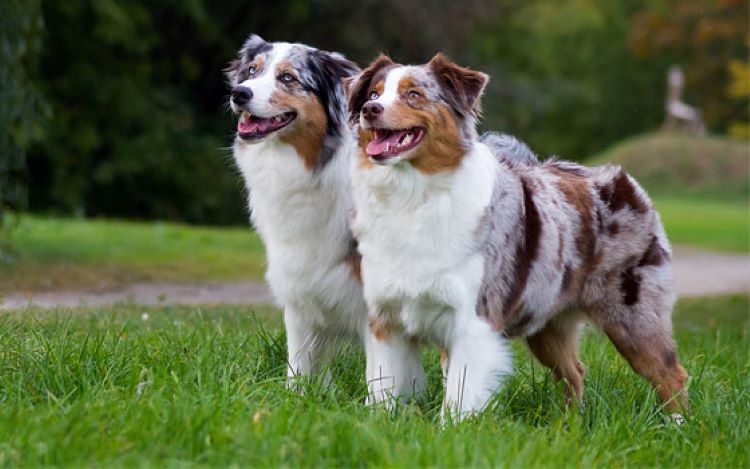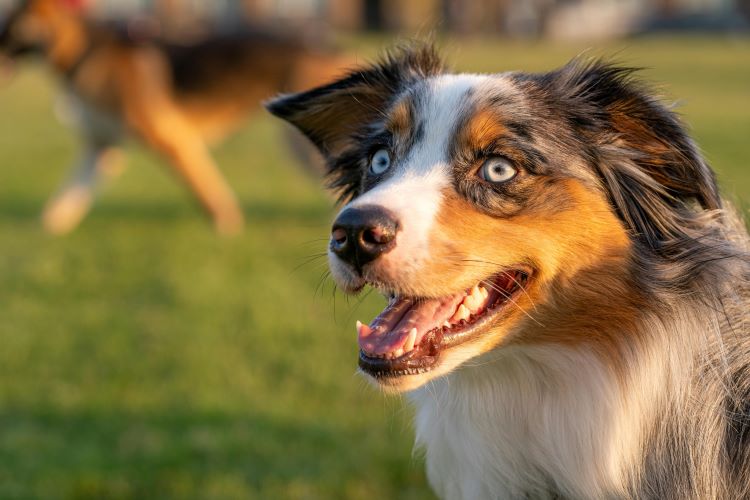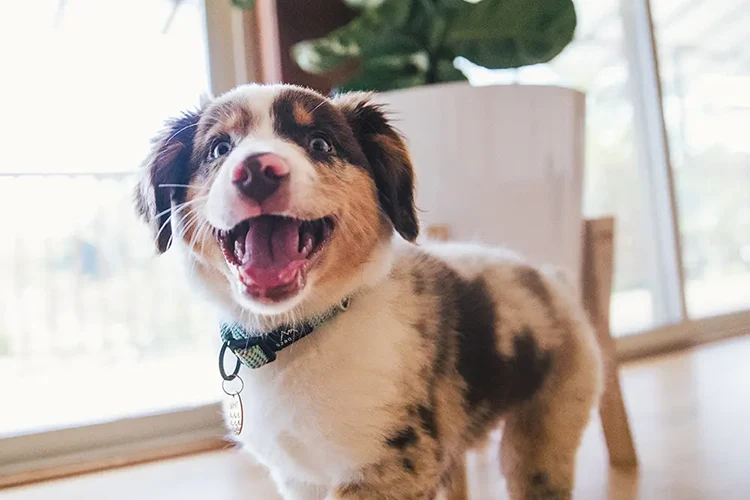Ready to help treat your pet to a healthy life?
Australian Shepherd Breed Guide: Fun Facts, Health & Care Tips
By : Trupanion Staff | Updated Oct 24, 2024

It's easy to recognize an Australian Shepherd or "Aussie" dog. These beautiful pups are known for their striking pale eyes, usually accompanied with a happy expression and bright demeanor. And, as many Aussie dog owners will tell you, they're almost always down for an adventure or two (or three — these dogs have the drive and energy!). But how much do you actually know about the Australian Shepherd? And, if you're currently considering bringing a new dog into the family, are they the right breed for you?
As with any kind of dog, Aussies are individuals who come with their own nuanced personalities and quirks. However, there are certain things you can anticipate in terms of health, appearance, and, yes, personality, due to their genetics. In this dog breed guide, we're taking a deep dive into where these dogs come from (no, it's not Australia), what to expect as a pet owner, and how you can give them the best life possible. We'll even throw in some fun facts along the way. Ready? Let's go!
What is an Australian Shepherd?
The Australian Shepherd is a type of shepherd dog, which is a subset of herding dog breeds. As such, they tend to have a durable build to withstand long hours outdoors in varying weather conditions. They have a silky soft, waterproof double coat that grows to a medium length. Some have wavier fur than others, but most have extra thick back feather fur, resembling puffy pirate pantaloons.
Aussies are seen in four different color variations: black, red, blue merle, and red merle. All of these colors can have tan and white markings, which means you might see a tri-colored Aussie. The Australian Shepherd also might have light blue eyes. This breed is known to have a condition called heterochromia, which gives them blue eyes, hazel or brown eyes, one of each, or eyes that have two colors in each.

Unique personality
When it comes to temperament, Australian Shepherds are known for their intelligence and energy. While they are not hyperactive, they do need to be actively engaged to avoid unruly behavior. They are highly trainable and thrive on mental and physical stimulation, making them excellent working dogs and companions.
While Aussies are known to be friendly and affectionate, they can be reserved around strangers and require proper socialization. They are also protective, making them good watchdogs. Overall, these pups are loving, devoted, and full of life, requiring engaged owners who can meet their active needs.
Similar dog breeds
- Border Collie
- Pyrenean Shepherd
- Blue Heeler
- Australian Cattle Dog
- Collie
- Shetland Sheepdog
- Miniature American Shepherd
5 fun facts about Aussie dogs
- Don’t let their name fool you — the Australian Shepherd is not a dog breed native to Australia. These dogs were refined in the American West during the late 1800s and early 1900s (see more in the history section below).
- According to legends, Native Americans called the Australian Shepherds “ghost eye” dogs and revered them as sacred. Many Aussies have pale blue eyes (or a combination of blue and other colored eyes).
- The Aussie is a quintessential ranch dog. After World War II, they could be seen performing tricks with cowboys and showing off their skills at rodeos.
- An Australian Shepherd named Harley was adopted in 2017 by Vice President Mike Pence.
- While popular throughout the mid 20th century, the Australian Shepherd wasn’t officially recognized by the American Kennel Club until 1991.
History of the Australian Shepherd dog breed
The Australian Shepherd’s history can be traced back to the Basque region of Spain and France, where Pyrenean Shepherds were the herding dog of choice by the talented herdsman of the region. So why the "Australian" name, you ask? As it turns out, these Basque shepherds emigrated to Australia in the 1800s, and their herding dogs traveled with them. It’s believed, during their time in Australia, these dogs were crossed with Collies and Border Collies. Eventually, the Basque immigrants made their way across the Pacific to the vast American West. The breed’s name is most likely due to its long journey to the United States by way of Australia.
These herding dogs became a popular choice for ranchers in the rough terrain of California and Colorado. They were unaffected by the higher altitudes of mountain ranches and were excellent working dogs with the stamina to herd all day. The Australian Shepherd breed was refined during the late 1800s and early 1900s by ranchers in the west, technically making it an American breed.
North American history
The Aussie didn’t explode onto the popular scene until after World War II when western riding and rodeos became a popular pastime. Aussies would help cowboys herd livestock at rodeos and then put on a show with tricks and performances. The dogs made appearances in mid-century western films and became an integral part of cowboy culture in America. As the breed spread beyond the west, they excelled in many different roles, working as service dogs, in search and rescue, and even drug detection jobs. Even though they are more of a newcomer to the American Kennel Club’s official breed list (recognized in 1991), they ranked as the 17th most popular dog breed in 2018.
Behavior and training
Australian Shepherds are rockstars in training and need a committed owner who will sign up for a dog sport or provide other regular physical and mental activity. If this breed doesn’t have a job to do, they will create their own — and they often decide that herding the children or other pets is the job for them. Aussies are quite food motivated, but also respond well to toys and play when used as training rewards.
It’s important to work on nipping and herding behavior from a young age with these dogs, giving them appropriate outlets for these behaviors as puppies and redirecting them when they start to herd the wrong things.
Do Australian Shepherds play well with others?
Australian Shepherds can be reserved and cautious when first meeting new people, and need time to get comfortable. Many Aussies enjoy attention if they have been introduced to it from puppyhood in a positive way. Proper proactive exposure to new sights, sounds, people, dogs, and other animals as a young puppy is essential for their socialization skills.
This Aussie has natural herding instincts that can make living with younger children difficult. They will do better with older children that don’t run around or squeal, which often triggers herding and nipping behavior. However, Australian Shepherds can make fantastic family dogs if socialized with children from puppyhood and given appropriate outlets for their herding instincts. Children should always be taught how to interact with dogs respectfully and politely to help keep everyone safe. Young children and dogs should always be supervised, and it’s helpful for a dog to have their own “safe space” where they can go when they need some quiet time.
This breed can do well with other pets in the home, as long as their herding behavior is managed, and they have been well socialized. Introducing pets to each other should be done in small increments, always focusing on creating positive associations with each other, and rewarding calm behavior. Herding dogs can sometimes overwhelm other dogs during play, with herding and nipping. Make sure to manage playtime between an Aussie and other dogs to ensure everyone is having a good time.
Exercise
Australian Shepherds are long on endurance and make excellent running or hiking buddies. Provide your Aussie with at least an hour of physical exercise every day. Working different kinds of activity into exercise sessions helps to burn energy, so mix in games of fetch or frisbee with their regular walks.
While these dogs do need lots of physical activity, it’s also essential to give them time to recharge. Their herding instincts mean they’re very responsive to movement and other environmental stimuli. If they are constantly busy, they can become overstimulated, nervous, and reactive. After lots of exercise, make sure they have a quiet place to relax and recover.
Speak with your veterinarian about appropriate exercise for an Australian Shepherd puppy. Until they are full-grown (bone growth plates typically all close between 12 and 18 months of age), avoid strenuous or repetitive activities like jogging or running — as this can increase their risk of damage to the growing bone and cartilage, causing pain and future joint issues.

Mental enrichment
Without a herd of sheep to work, an Aussie needs an outlet for their mental energy. By giving them mental enrichment, you’ll prevent boredom and the unwanted behaviors that boredom often causes. Give your Australian Shepherd interactive toys, feed them their regular meals from food puzzles, practice nose work, and incorporate lots of trick training into their daily routine. Mental enrichment will help an Aussie puppy learn good habits from a young age, and give them an appropriate outlet for instinctual behaviors like chewing, digging, or herding.
Ideal dog activities for Aussies
Australian Shepherds do well in many different activities:
- Agility
- Disc Dog
- Herding activities
- Treibball
- Nosework / tracking
- Flyball
- Rally obedience
- Therapy work
- Search and Rescue
- Skijoring
Health and care tips for pet owners
All dogs, regardless of breed, are predisposed to certain health conditions. This doesn't mean your dog is guaranteed to get sick, however. Instead, all it means is that you should take some time to learn your dog's risks and take preventative measures where possible. This includes routine veterinary checkups, monthly parasite prevention, and protecting your pet with a good dog insurance plan. Some common health conditions in Aussies to be aware of include (but may not be limited to) the following:
- Hip and elbow dysplasia — A genetic condition where the joint doesn't fit properly into the hip socket, leading to arthritis. Left untreated, the condition can lead to pain and lameness (find out if pet insurance covers joint dysplasia).
- Progressive retinal atrophy (PRA) — A genetic eye disorder that can lead to blindness over time.
- Collie eye anomaly (CEA) — Another eye condition primarily affecting herding dog breeds that can cause vision problems.
- Degenerative myelopathy — A progressive disease of the spinal cord that can lead to mobility issues.
- Allergies — Some Aussies may suffer from skin allergies or food sensitivities.
- Epilepsy — This breed can be prone to seizures due to genetic factors.
- Hypothyroidism — An underactive thyroid can lead to weight gain, lethargy, and skin issues.
- Stress and anxiety — high-energy dogs like Aussies can become anxious if their physical and mental needs aren't being met.
Talk with your veterinarian about your dog's particular health risks. Your Aussie's lifestyle also plays a huge role in their health, so be sure to meet their exercise and enrichment needs mentioned earlier.
Grooming tips
Australian Shepherds need regular brushing to keep tangling at bay and to distribute natural oils throughout the coat. They usually don’t need bathing unless they get especially dirty, as their coat tends to slough off dirt and any smells between baths (as long as it’s brushed). Aussies shed year-round, but you might notice an increase of shedding during seasonal “blowing of coat,” which tends to happen during spring and fall.
Best Brush for an Australian Shepherd: Pin comb, Slicker Brush, Undercoat rake

Australian Shepherds in pop culture
Past and present, Aussies are no strangers to the homes of celebrities and being familiar faces in media.
Famous Owners of the Australian Shepherd
- Amanda Seyfried (Actress)
- Alyssa Milano (Actress)
- James Brolin (Actor)
- Trace Adkins (Singer)
- Steven Spielberg (Director)
- Mel Gibson (Actor)
- Paul Bettany and Jennifer Connelly (Actors)
- Jay Sisler (Actor)
- Flip Wilson (Comedian)
- Devin O’Branagan (Author)
- Mike Pence (Politician)
Famous Australian Shepherds
- Bunk — the sidekick of silent-era film cowboy Jack Hoxie
- Stubby, Shorty, and Queenie — Trainer Jay Sisler's rodeo performance dogs who were also featured in several Disney movies.
